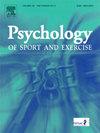Within-person associations between daily stress and physical activity during working and non-working hours
IF 3.1
2区 心理学
Q2 HOSPITALITY, LEISURE, SPORT & TOURISM
引用次数: 0
Abstract
People experience stressors on 40% of days, and emotional responses to stressors increase the risk for poor health, in part by impacting health behaviors like physical activity (PA). However, whether associations of daily psychological stressors with PA after the self-reported stressor occurs (post-stressor PA) differ across working and non-working hours is unclear. This study used the National Study of Daily Experiences III (2017–2019) to examine within-person associations between stressors and post-stressor PA during working and non-working hours and moderation by age and biological sex. Participants completed interviews across eight consecutive days about daily stress and the amount and timing of PA participation during the past 24 hours. Multilevel models with days nested in people examined the within-person associations of stressors with the odds and amount of post-stressor PA participation, with separate models during versus outside of working hours on working days and for non-working days. Participants (N = 564) had higher odds of post-stressor PA during working hours when they experienced greater than usual anger (OR = 3.24, p < .001), sadness (OR = 2.41, p < .001), or shame (ORs = 2.59, p < .001) due to stress. Sex moderated the within-person associations between stressor frequency (OR = 0.29, p < .001), intensity (OR = 0.49, p < .001), and anxiety (OR = 0.58, p = .002) on odds of post-stressor PA during working hours, such that the increased odds were higher in males. Participants had higher odds of post-stressor PA outside of working hours when they experienced greater stress intensity, anger, sadness, shame, or anxiety (OR = 3.94–7.35, p < .001). Research clarifying how age, sex, and/or occupation intersect with individuals’ daily stress experiences and PA could inform occupational health policies and/or interventions.
日常压力与工作时间和非工作时间体育活动之间的人际关系。
人们在 40% 的日子里都会遇到压力,而对压力的情绪反应会增加健康不良的风险,部分原因是会影响体育锻炼(PA)等健康行为。然而,日常心理压力与自我报告压力发生后的体育锻炼(压力后体育锻炼)之间的关系在工作时间和非工作时间是否存在差异尚不清楚。本研究利用 "全国日常经历研究 III(2017-2019 年)"来考察工作和非工作时间内压力源与压力源后 PA 之间的人际关联,以及年龄和生理性别的调节作用。参与者在连续八天内完成了关于日常压力以及过去 24 小时内参与 PA 的数量和时间的访谈。将天数嵌套在人中的多层次模型考察了压力源与压力源后参与体育锻炼的几率和数量之间的人内关联,并分别建立了工作日和非工作日工作时间内和非工作时间外的模型。当参与者(N=564)在工作时间内比平时更容易发怒时,他们在压力后参加体育锻炼的几率更高(OR=3.24,p<0.05)。
本文章由计算机程序翻译,如有差异,请以英文原文为准。
求助全文
约1分钟内获得全文
求助全文
来源期刊
CiteScore
6.40
自引率
5.90%
发文量
172
审稿时长
69 days
期刊介绍:
Psychology of Sport and Exercise is an international forum for scholarly reports in the psychology of sport and exercise, broadly defined. The journal is open to the use of diverse methodological approaches. Manuscripts that will be considered for publication will present results from high quality empirical research, systematic reviews, meta-analyses, commentaries concerning already published PSE papers or topics of general interest for PSE readers, protocol papers for trials, and reports of professional practice (which will need to demonstrate academic rigour and go beyond mere description). The CONSORT guidelines consort-statement need to be followed for protocol papers for trials; authors should present a flow diagramme and attach with their cover letter the CONSORT checklist. For meta-analysis, the PRISMA prisma-statement guidelines should be followed; authors should present a flow diagramme and attach with their cover letter the PRISMA checklist. For systematic reviews it is recommended that the PRISMA guidelines are followed, although it is not compulsory. Authors interested in submitting replications of published studies need to contact the Editors-in-Chief before they start their replication. We are not interested in manuscripts that aim to test the psychometric properties of an existing scale from English to another language, unless new validation methods are used which address previously unanswered research questions.

 求助内容:
求助内容: 应助结果提醒方式:
应助结果提醒方式:


